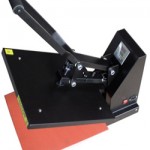 You remember iron-on patches. That same low-tech method our mothers and grandmothers used to do a quick repair on our jeans is still one of the most popular ways to put images on t-shirts, but new technology is making it easier to make your own designs. Instead of making your first stop the fabric or craft store, head to the computer or office supply store. There you’ll find that t-shirt making is going high tech. New printers, transfer paper, inks, and computer programs are making designing and printing your own t-shirts at home easier than ever. Start with the right transfer paper for your printer. Check the package and be sure it’s compatible. The pros say it’s easier to transfer images to light colored shirts. If you are planning on using a dark t-shirt, there is paper specifically designed for those colors.
You remember iron-on patches. That same low-tech method our mothers and grandmothers used to do a quick repair on our jeans is still one of the most popular ways to put images on t-shirts, but new technology is making it easier to make your own designs. Instead of making your first stop the fabric or craft store, head to the computer or office supply store. There you’ll find that t-shirt making is going high tech. New printers, transfer paper, inks, and computer programs are making designing and printing your own t-shirts at home easier than ever. Start with the right transfer paper for your printer. Check the package and be sure it’s compatible. The pros say it’s easier to transfer images to light colored shirts. If you are planning on using a dark t-shirt, there is paper specifically designed for those colors.
While you’re at the computer store, check out programs that design shirts for you! They come with images, graphics, fonts, frames and more. The programs help you pick the right image size for where you want the design to go on your shirt. You might want a larger image if it’s on the back than on the front. Or, something small if it’s a simple name or logo over the left front pocket. T-shirt design programs also have photo-editing programs if you want to put a picture on your shirt.
You can also create images on your own or use logos and print them right onto the transfer paper. Just follow the directions that come with the paper. You’ll want to check those directions for heat temperature, too. It’s important that your iron is just right to prevent cracking and to be sure the image adheres to the shirt fabric. New developments in how transfer paper is made and how it works with your printer are solving the cracking problem. But, you want your design to stick for more than one trip through the washing machine. When you wash the fabric, it’s best if you do it by hand or wash it in the gentle cycle so the image does not crack or fade.
The quality of t-shirt is important, too. It used to be that you could only use heat transfer on cotton or cotton blends. Now, new transfer papers allow you to apply heat transfer images to 100% synthetic materials. Again, be sure to check the transfer paper package to be sure which fabrics produce the best results. Heat transfer is an ideal way to make one t-shirt or a small batch of t-shirts at home. You just create the design on your computer, print onto the transfer paper and then iron. It’s easy to make small adjustments like adding a different name for each shirt, making small design changes, or moving where you want the design to be on a shirt. Just make the changes on your computer and reprint onto new transfer paper.
If it sounds like too much work you might want to consider designing your own t-shirt and having us print it using our advanced Direct-to-Garment printing.
